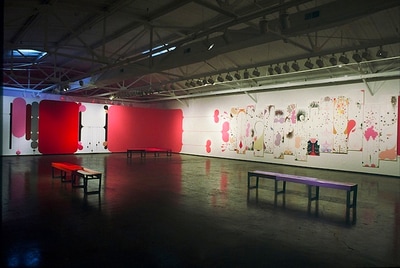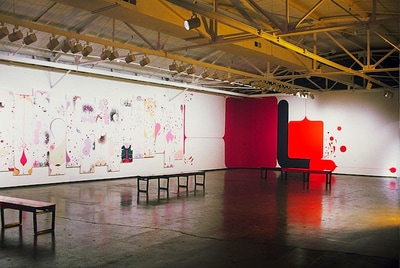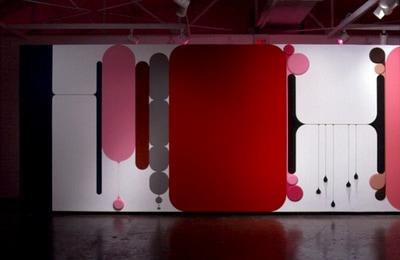Elevatious Transcendsualistic 2002 Diverse Works
Elevatious Transcendsualistic 2002 Diverse Works
Huston Press: Artist in Wonderland Paul Henry Ramirez tumbles down the rabbit hole at DiverseWorks, Sept 2002, By John Devine
Elevatious Transcendsualistic, the title of the Paul Henry Ramirez installation that kicks off the visual arts season at DiverseWorks, suggests a project conceived by Mary Poppins and Carl Jung after they’d been introduced to each other by Lewis Carroll. And stepping around the pink-lit wall where the title spirals like a cheesy flashback/ dream effect from an old movie is a bit like falling down a rabbit hole into a phantasmagoric world of extravagant shapes and colors. Taking over almost three-quarters of the main gallery and applied to a custom-built curved wall, the installation focuses on 14 abstract paintings, each 18 feet by two feet and hung on the vertical, tight against one another and staggered, so that they present a jagged line at top and bottom. They almost get lost in the crowd of other visual elements — large rounded squares and rectangles, raised varicolored circles and “appendages” — but, fortunately for the bedazzled viewer, those elements also point the way to the paintings.
But some background is needed. Ramirez is a native Texan, born in El Paso in 1963, who now lives in New York, and this is the third version of Elevatious Transcendsualistic. Previous avatars have appeared at Caren Golden Fine Art in Manhattan and Cincinnati’s Contemporary Arts Center; its fourth (and final) manifestation will be at the Tang Teaching Museum in Saratoga Springs, New York, which will publish a catalog documenting the installation’s journey and variations. In each incarnation, the installation has responded uniquely to the architectural space it finds itself in; here, for the first time, the paintings are presented as a single unit.
The paintings themselves are exuberantly frenetic, a more-than-lively dance of biomorphic figuration, suggestive of — oh, the hell with it. A friend urged me to describe these paintings as being all “boobies and pubies and buttocks,” and why not? A couple of women were heard wondering, “Are these paintings ‘dirty’ or is it me?” For the record, ladies, it’s you — I didn’t see so much as a single smudge of dirt anywhere on these paintings.
They are riotously libidinous, however, pulsing with a vitality that pushes against their ornateness. Along with the three elements mentioned above, there are a lot of juices splashing around on these panels, lubricating the tension between their biomorphic sensuality and the more sterile pleasure of their decorativeness. Parameciumlike ovals bulge and contract, as if in the throes of division, while multicolored ova and monochromatic bubbles bounce and swirl past sprouting black tendrils and bulbous squirts. Indeed, there is so much energy here that the individual panels cannot contain it; some shapes come right to the edges of the canvases and disappear into the interstices between them — or are they bubbling out of them?
The wall designs bring further tension to this little narrative of vital energies versus mere decoration. With their more regular forms and monolithic dimensions, the wall elements partake more of the architecture — they’re on its side, if you will. Marching along the wall from opposite directions, these architectural elements send out extensions to contain and even squeeze the paintings together; hence their staggered hanging. Is this some allegory about the antipathy of architecture to painting? No, it’s much more playful than that. Otherwise, you might not be inclined to accept the invitation extended by the three colorful benches — designed by local architect Keith Krumwiede — to sit and linger for the accompanying sound installation by So Takahashi and Takako Minekawa. And you’ll want to linger — Elevatious Transcendsualistic is great fun and a terrific start to DiverseWorks’s season.
Huston Press: Artist in Wonderland Paul Henry Ramirez tumbles down the rabbit hole at DiverseWorks, Sept 2002, By John Devine
Elevatious Transcendsualistic, the title of the Paul Henry Ramirez installation that kicks off the visual arts season at DiverseWorks, suggests a project conceived by Mary Poppins and Carl Jung after they’d been introduced to each other by Lewis Carroll. And stepping around the pink-lit wall where the title spirals like a cheesy flashback/ dream effect from an old movie is a bit like falling down a rabbit hole into a phantasmagoric world of extravagant shapes and colors. Taking over almost three-quarters of the main gallery and applied to a custom-built curved wall, the installation focuses on 14 abstract paintings, each 18 feet by two feet and hung on the vertical, tight against one another and staggered, so that they present a jagged line at top and bottom. They almost get lost in the crowd of other visual elements — large rounded squares and rectangles, raised varicolored circles and “appendages” — but, fortunately for the bedazzled viewer, those elements also point the way to the paintings.
But some background is needed. Ramirez is a native Texan, born in El Paso in 1963, who now lives in New York, and this is the third version of Elevatious Transcendsualistic. Previous avatars have appeared at Caren Golden Fine Art in Manhattan and Cincinnati’s Contemporary Arts Center; its fourth (and final) manifestation will be at the Tang Teaching Museum in Saratoga Springs, New York, which will publish a catalog documenting the installation’s journey and variations. In each incarnation, the installation has responded uniquely to the architectural space it finds itself in; here, for the first time, the paintings are presented as a single unit.
The paintings themselves are exuberantly frenetic, a more-than-lively dance of biomorphic figuration, suggestive of — oh, the hell with it. A friend urged me to describe these paintings as being all “boobies and pubies and buttocks,” and why not? A couple of women were heard wondering, “Are these paintings ‘dirty’ or is it me?” For the record, ladies, it’s you — I didn’t see so much as a single smudge of dirt anywhere on these paintings.
They are riotously libidinous, however, pulsing with a vitality that pushes against their ornateness. Along with the three elements mentioned above, there are a lot of juices splashing around on these panels, lubricating the tension between their biomorphic sensuality and the more sterile pleasure of their decorativeness. Parameciumlike ovals bulge and contract, as if in the throes of division, while multicolored ova and monochromatic bubbles bounce and swirl past sprouting black tendrils and bulbous squirts. Indeed, there is so much energy here that the individual panels cannot contain it; some shapes come right to the edges of the canvases and disappear into the interstices between them — or are they bubbling out of them?
The wall designs bring further tension to this little narrative of vital energies versus mere decoration. With their more regular forms and monolithic dimensions, the wall elements partake more of the architecture — they’re on its side, if you will. Marching along the wall from opposite directions, these architectural elements send out extensions to contain and even squeeze the paintings together; hence their staggered hanging. Is this some allegory about the antipathy of architecture to painting? No, it’s much more playful than that. Otherwise, you might not be inclined to accept the invitation extended by the three colorful benches — designed by local architect Keith Krumwiede — to sit and linger for the accompanying sound installation by So Takahashi and Takako Minekawa. And you’ll want to linger — Elevatious Transcendsualistic is great fun and a terrific start to DiverseWorks’s season.


